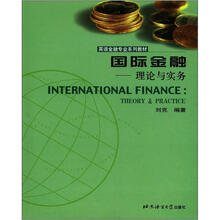英语金融专业系列教材·国际金融:理论与实务

目 录内容简介
Chapter 1 The Balance of Payments
1.1 Accounting Principles
1.1.1 Debit and Credit
1.1.2 Double-Entry Accounting
1.2 Balance-of-Payments Structure
1.2.1 The Current Account
1.2.2 The Capital Account
1.2.3 The Financial Account
1.2.4 Statistical Discrepancy: Errors and Omissions
1.3 Classification of Transactions
1.4 Balance-of-Payments Equilibrium
Summary
Questions for Review
Ptoblems and Applications
References
Chapter 2 Balance-of-Payments Adjustment and Determinants of the Balance of Trade and Payments
2.1 BOP Adjustments under Fixed Exchange Rates
2.1.1 Price Adjustments
2.1.2 Balance-of-Payments Adjustments
2.1.3 Interest-Rate Adjustments
2.1.4 Capital Flows and the Balance of Payments
2.1.5 Income Adjustments
2.1.6 Monetary Adjustments
2.2 Determinants of Balance of Trade and Payments
2.2.1 Elasticities Approach to Exchange-Rate Adjustment
2.2.2 Absorption Approach to Exchange-Rate Adjustment
2.2.3 Monetary Approach to the Balance of Payments
Summary
Questions for Review
Ptoblems and Applications
References
Chater 3 International Monetary System
3.1 The Gold Standard Era, 1870-1914
3.1.1 Origins of the Gold Standard
3.1.2 The Gold Standard Rules
3.1.3 The Automatic Adjustment Mechanism under the Gold Standard
3.2 The Inter-War Period, 1919-1939
3.3 The Bretton Woods Period, 1946 -1971
3.3.1 Goals and Structure of the IMF
3.3.2 Operation of the Bretton Woods System
3.3.3 Evolution of the Bretton Woods System
3.3.4 Collapse of the Bretton Woods System
3.4 The Floating Rate Period, 1971 to Ptesent
3.5 Optimum Currency Areas and the EMS
3.6 The Euro
Summary
Questions for Review
Problems and Applications
References
Chapter 4 Exchange-Rate Systems
4.1 Foreign Exchange-Rate Practices
4.2 Fixed Exchange-Rate System
4.2.1 Advantages of a Fixed Exchange-Rate System
4.2.2 Disadvantages of a Fixed Exchange-Rate System
4.2.3 Exchange-Rate Stabilization
4.3 Flexible Exchange-Rate System
4.3.1 Achieving Market Equilibrium
4.3.2 Advantages of a Floating Exchange-Rate System
4.3.3 Disadvantages of a Floating Exchange-Rate System
……
Chapter 5 Foreign-Exchange Market and Financial Derivatives
Chapter 6 Exchange Rates,Interest Rates,and Interest Parity
Chapter 7 Foreign-Exchange Risk and Forecasting
Chapter 10 Financial Management of the Multinational Enterprises
Chapter 11 International Banking:Reserves,Debt,and Risk
Chapter 12 Macroecononuc Policy in the Open Economy
1.1 Accounting Principles
1.1.1 Debit and Credit
1.1.2 Double-Entry Accounting
1.2 Balance-of-Payments Structure
1.2.1 The Current Account
1.2.2 The Capital Account
1.2.3 The Financial Account
1.2.4 Statistical Discrepancy: Errors and Omissions
1.3 Classification of Transactions
1.4 Balance-of-Payments Equilibrium
Summary
Questions for Review
Ptoblems and Applications
References
Chapter 2 Balance-of-Payments Adjustment and Determinants of the Balance of Trade and Payments
2.1 BOP Adjustments under Fixed Exchange Rates
2.1.1 Price Adjustments
2.1.2 Balance-of-Payments Adjustments
2.1.3 Interest-Rate Adjustments
2.1.4 Capital Flows and the Balance of Payments
2.1.5 Income Adjustments
2.1.6 Monetary Adjustments
2.2 Determinants of Balance of Trade and Payments
2.2.1 Elasticities Approach to Exchange-Rate Adjustment
2.2.2 Absorption Approach to Exchange-Rate Adjustment
2.2.3 Monetary Approach to the Balance of Payments
Summary
Questions for Review
Ptoblems and Applications
References
Chater 3 International Monetary System
3.1 The Gold Standard Era, 1870-1914
3.1.1 Origins of the Gold Standard
3.1.2 The Gold Standard Rules
3.1.3 The Automatic Adjustment Mechanism under the Gold Standard
3.2 The Inter-War Period, 1919-1939
3.3 The Bretton Woods Period, 1946 -1971
3.3.1 Goals and Structure of the IMF
3.3.2 Operation of the Bretton Woods System
3.3.3 Evolution of the Bretton Woods System
3.3.4 Collapse of the Bretton Woods System
3.4 The Floating Rate Period, 1971 to Ptesent
3.5 Optimum Currency Areas and the EMS
3.6 The Euro
Summary
Questions for Review
Problems and Applications
References
Chapter 4 Exchange-Rate Systems
4.1 Foreign Exchange-Rate Practices
4.2 Fixed Exchange-Rate System
4.2.1 Advantages of a Fixed Exchange-Rate System
4.2.2 Disadvantages of a Fixed Exchange-Rate System
4.2.3 Exchange-Rate Stabilization
4.3 Flexible Exchange-Rate System
4.3.1 Achieving Market Equilibrium
4.3.2 Advantages of a Floating Exchange-Rate System
4.3.3 Disadvantages of a Floating Exchange-Rate System
……
Chapter 5 Foreign-Exchange Market and Financial Derivatives
Chapter 6 Exchange Rates,Interest Rates,and Interest Parity
Chapter 7 Foreign-Exchange Risk and Forecasting
Chapter 10 Financial Management of the Multinational Enterprises
Chapter 11 International Banking:Reserves,Debt,and Risk
Chapter 12 Macroecononuc Policy in the Open Economy
目 录内容简介
《英语金融专业系列教材·国际金融:理论与实务》是一部纯英文的教材,我们在力求准确表述作者思想的同时,又尽可能按中文的习惯在叙述一些难解的概念和理论问题时尽量采用由浅入深、数字说明的方法,力求做到简洁明了和条理清楚。
本书语言流畅,内容的难易安排合理适当,具有一定的深度,既适合于经济类各专业的本科生学习,又可以作为经济类专业的研究生进一步深入学习的教材。
本书语言流畅,内容的难易安排合理适当,具有一定的深度,既适合于经济类各专业的本科生学习,又可以作为经济类专业的研究生进一步深入学习的教材。
比价列表
| 商家 | 评价 (0) | 折扣 | 价格 |
 | 暂无 | 中图缺货N个月 |  704天前更新 |
公众号、微信群
 缺书网
缺书网微信公众号
 扫码进群
扫码进群实时获取购书优惠

